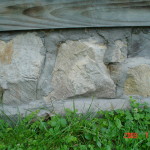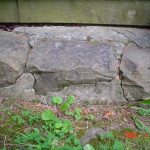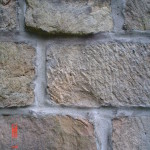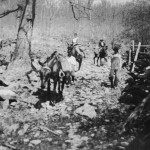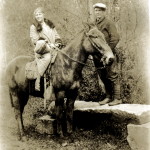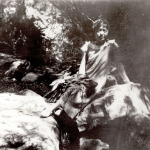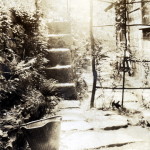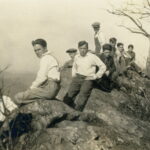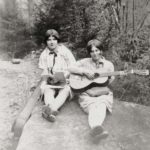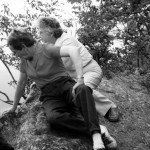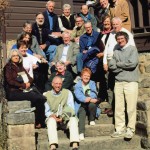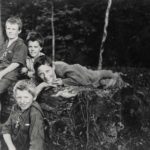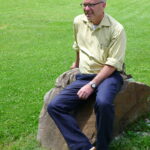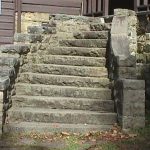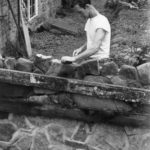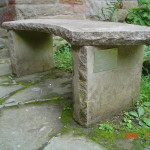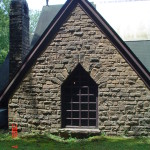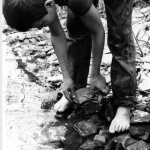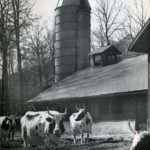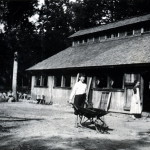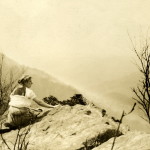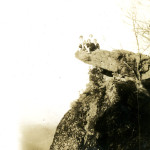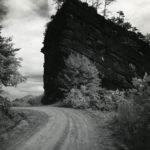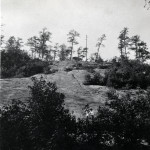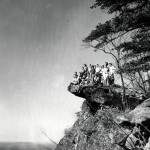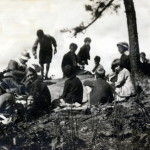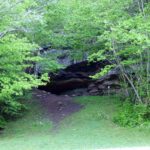Pine Mountain Settlement School
DANCING IN THE CABBAGE PATCH
Blog
STONES, MORE STONES AND SCALLOPED POTATOES
TAGS: DANCING IN THE CABBAGE PATCH Stones, More Stones and Scalloped Potatoes; Pine Mountain Settlement School; Harlan County, KY; stones; scalloped potatoes; rocks; agriculture; farms; farming; foodways; cooking; Raven’s Rock; limestone; geology; lime; lime burning; kilns; quick lime; Perry County; accidents; horses; horseback riding; doctors; Dr. Alfreda Withington;
On June 8, 1920 Katherine Pettit wrote to Martha Van Meter, a nurse at the Line Fork Settlement, requesting her to purchase some grey shambray so she could mount her paper maps and preserve them. She goes on to ask Miss Van Meter “How are you on library and office work and filing and such things or do you rather dig and pile rocks as I do?” Miss Van Meter’s response is not known but the exchange suggests that rocks were a constant measure of how one approached work at Pine Mountain. The memo also signals Pettit’s deep engagement with the land and its geography and geology.
ROCKS AND THE PINE MOUNTAIN RANGE
The geology of Pine Mountain is very complex. But one component is much in evidence. That is the stone. Limestone, conglomerate, shale, shist, coal, and sandstone are in abundance. From the bothersome creek boulders to the giant Rebel’s Rock, or the beautiful Raven’s Rock arch, stones in the region can charm and confound.
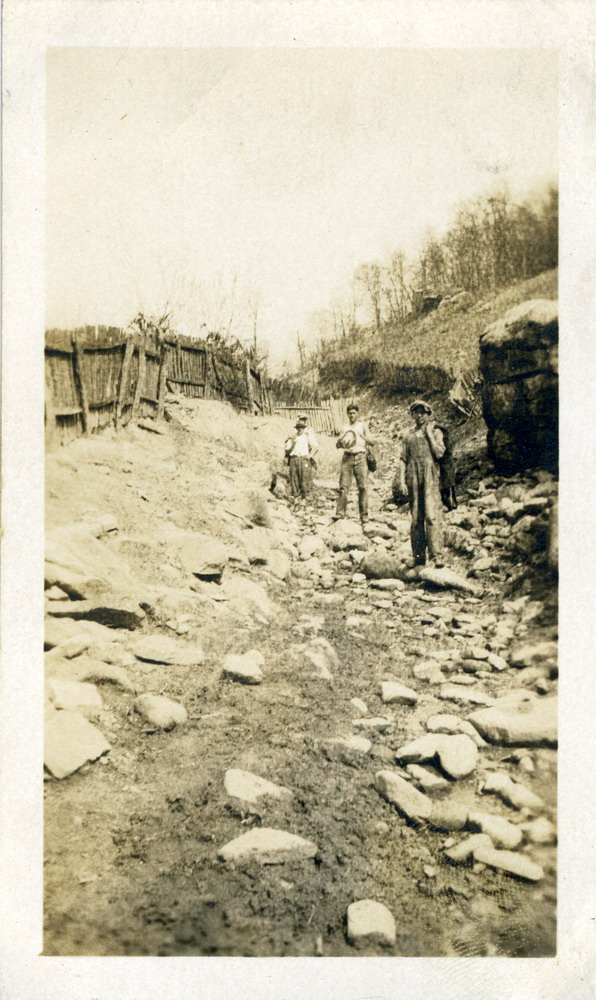
Kendall Bassett Photograph Album, c. 1928-1929. [pmss001_bas001.jpg]
One stone in plentiful supply in the Pine Mountain geology is limestone. Limestone is in rich supply in the valley of Pine Mountain. Often limestones and other stones were troublesome and were carried from the fields where they had troubled the plow. But some stones could be a gift. Limestone, for example, was a gift to the soil and to the farmer. Limestone is a stone that can be burned. But unlike coal, limestone, when burned, produces rich by-products. The richest of these by-products is known appropriately as “lime.” It is an important nutrient for many crops in the mountains of Eastern Kentucky and helps to neutralize the soil’s acidity.
While the burning of limestone for lime has consumed considerable forest throughout history, it is still well-known as a boost for tired soil. Today packaged in various fertilizers, it continues to be added to the soil to support crops and enhance grazing land. Before the importation of commercial fertilizers, however, lime was wrested from the stones of the surrounding mountains.
The history of lime-kilns goes far back in the history of the world and no doubt the practice came to the New World with our earliest ancestors and settlers. Until the advent of commercial fertilizers, the production of lime through lime kilns (the burning of limestone) was common throughout much of rural America. It was, however, not so common deep in the small valleys in Appalachia. The practice of burning limestone for fertilizer, according to some, was a practice that Pine Mountain Settlement brought to many in the local farming population, though the practice of adding lime was in practice before the School was founded.
The so-called “lime cycle” starts with the stone — technically known as calcium carbonate and carries the chemical compound symbols of CaCO3. The limestone is stacked over a fire fueled by wood or coal and layers of limestone and fuel are then alternated to create a sizable pile that will burn for 10 days or more. This “pile” generally reaches temperatures in excess of 1200 degrees Fahrenheit. The heat from the fire cooks off the carbon dioxide, CO2, and leaves a rich residue of carbonates (calcium oxide, CaO). This calcium oxide, also known as “quick lime” can then be applied directly to the soil, or better, can be mixed with water to de-acidify the soil.
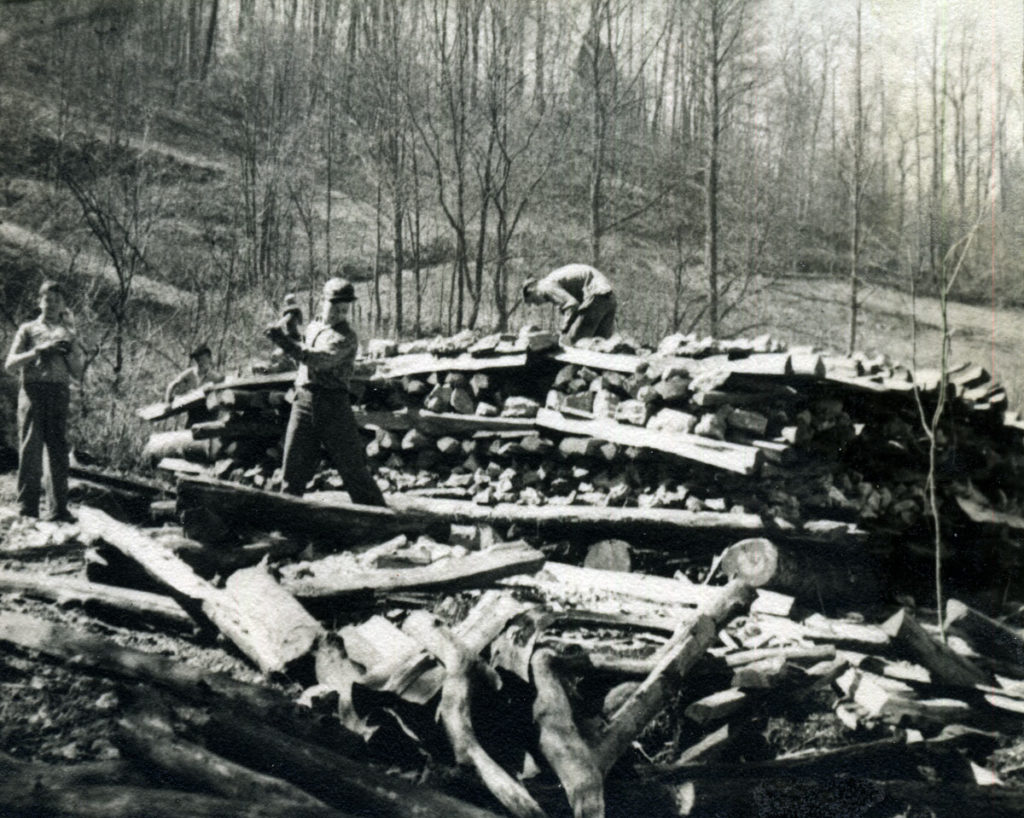
Building the llime-kiln 23_campus_work_052
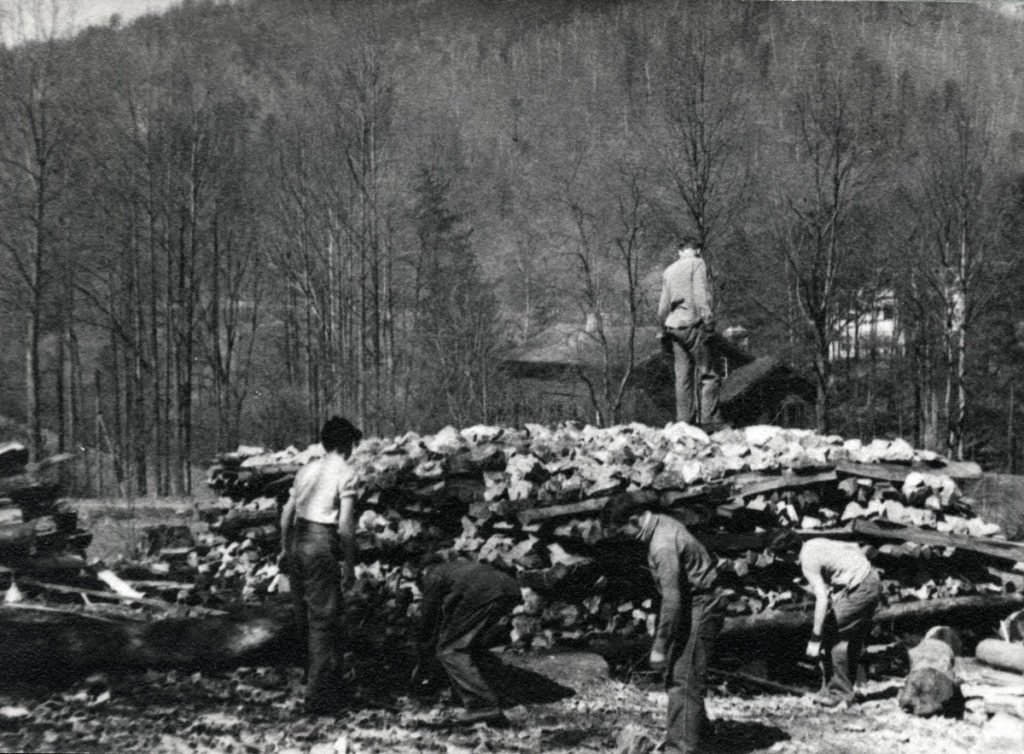
Stacking the lime-kiln 23_campus_work_050
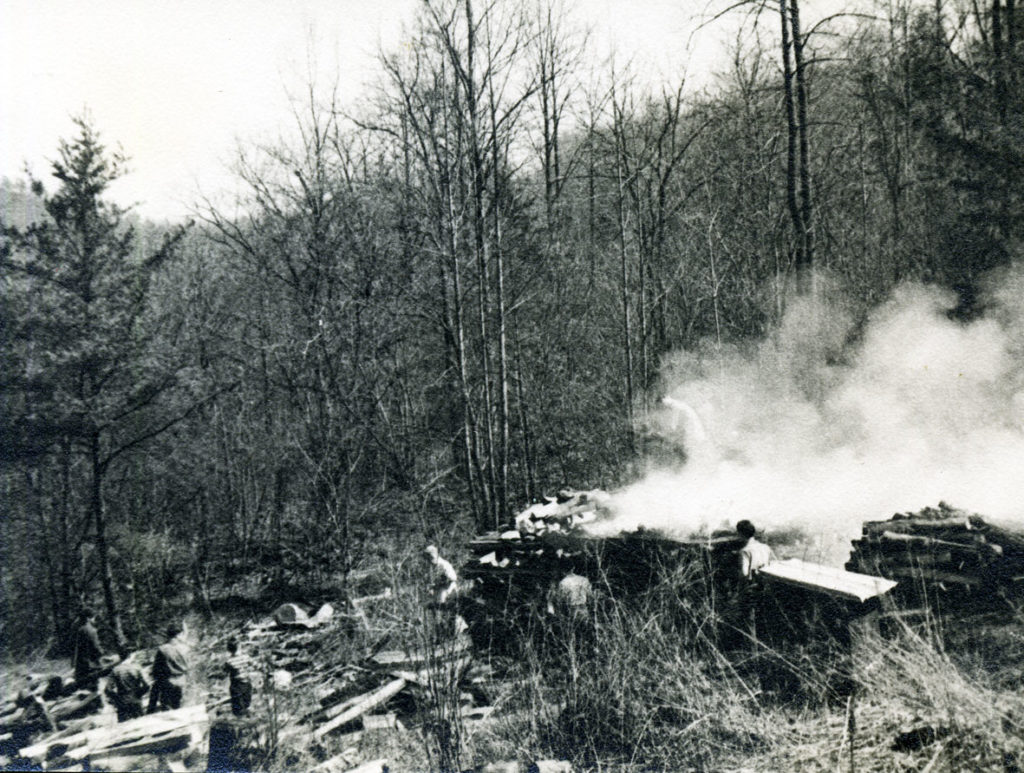
The lime-kiln fired-up and producing lime for farm land 23_campus_work_051
Quick lime can also be used to make “white wash,” an insect retardant “paint” often seen on the base of trees, or on fences or around the base of wooden structures in early Appalachian homesteads. Even much later, well into the 1950’s and 1960’s, homes sported trees with their bases white-washed or old tires painted white and filled with flowers or foundation stones supporting a home, carefully painted white. An important early use was hygienic. Lime was a key additive used to keep insects and disease at bay in the many privies of the Appalachians. Both lime and wood ash with its high concentration of lye were also used as alternative disease retardants in the privy. Today, lime is still used in water treatment and sewage treatment along with ferrous sulfate.
When quick lime is mixed with other additives, it can also be a key ingredient to strengthen concrete or added to stucco for the same purpose and for its pure white nature. It can bolster or build strong walls or can be used in ‘pointing’ stonework. Much of the concrete at the school used some local lime in the concrete mix. Today, the practice of burning lime has been replaced by commercial lime that may be purchased in fertilizer mixes and other commercial amalgams. The forest can be heard celebrating this turn toward commercial lime.
Analyzing and creating some of the early pointing concrete is an art. Pine Mountain has been fortunate to have Bob Yap’s good eye and deep knowledge of restoration when addressing many of the issues found in the stone foundations and sidings of many of the Pine Mountain buildings that have broken down with time. Yap’s annual workshops are some of the most exciting workshops held at PMSS. While Yap’s skills range across many restoration skills including window restoration, roof flashing, siding, fine carpentry, and so much more, he also addresses the vital skill or re-pointing rockwork. See the Pine Mountain schedule of events and workshops for dates the next series of restoration workshops.
- Old Log foundation. [rockwork_067_oldlog_foundation.jpg]
- Old Log step. [rockwork_066_oldlog_step.jpg]
- Old Log chimney. [rockwork_065_oldlog_chimney_detail.jpg]
STONES AND MORE STONES
Stones in the Pine Mountain valley are everywhere present. They fill stream beds, sometimes tumble down mountains, pose major obstacles in the construction of roads and homes, or provide the central building material of the same. They are rockwalls, laid dry-stacked one on the other and stone mantles above the stone fireplace. They mark the well-traveled paths around the campus. They hide the infrequent copperhead snake and the quick-witted “red-britches” ground squirrel. Stones are in evidence at every turn at the School and they are still being added to the landscape in the dry stack workshops that have now become an annual offering at the School.
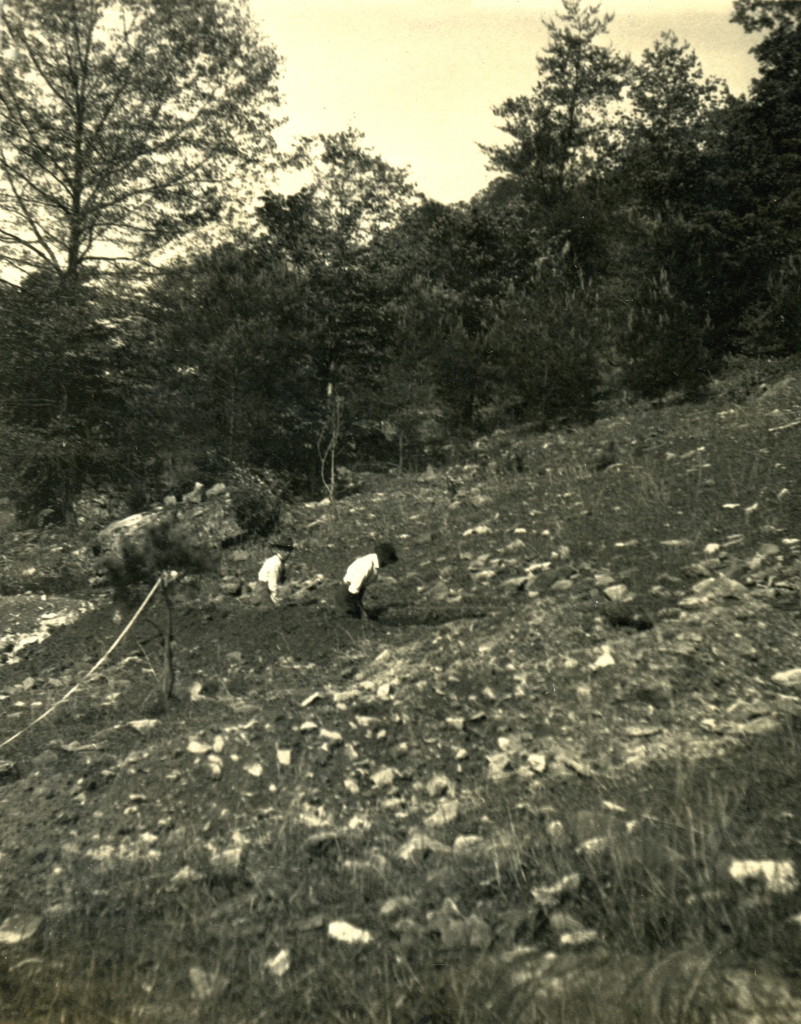
From Mary Rockwell Hook Album. [hook_album_2blk__036]
Stone at the School can be found in flagstone walks and simple stream stepping stones. Rocks are often referred to as residing deep in the woods, where they are natural monuments with trillium tops and gentle fern and lichen-laced sides. They are places to sit for a stream-side picnic or a personal reverie. At Pine Mountain, almost no one is without a stone — or some affection for a “rock.” The Playground rock beside Isaac’s Creek is one of the most iconic rocks at the School. The large rock (no one calls it a stone) is nearly encased in the root of a giant poplar tree and provides many nooks to play or sit, or cut hair.
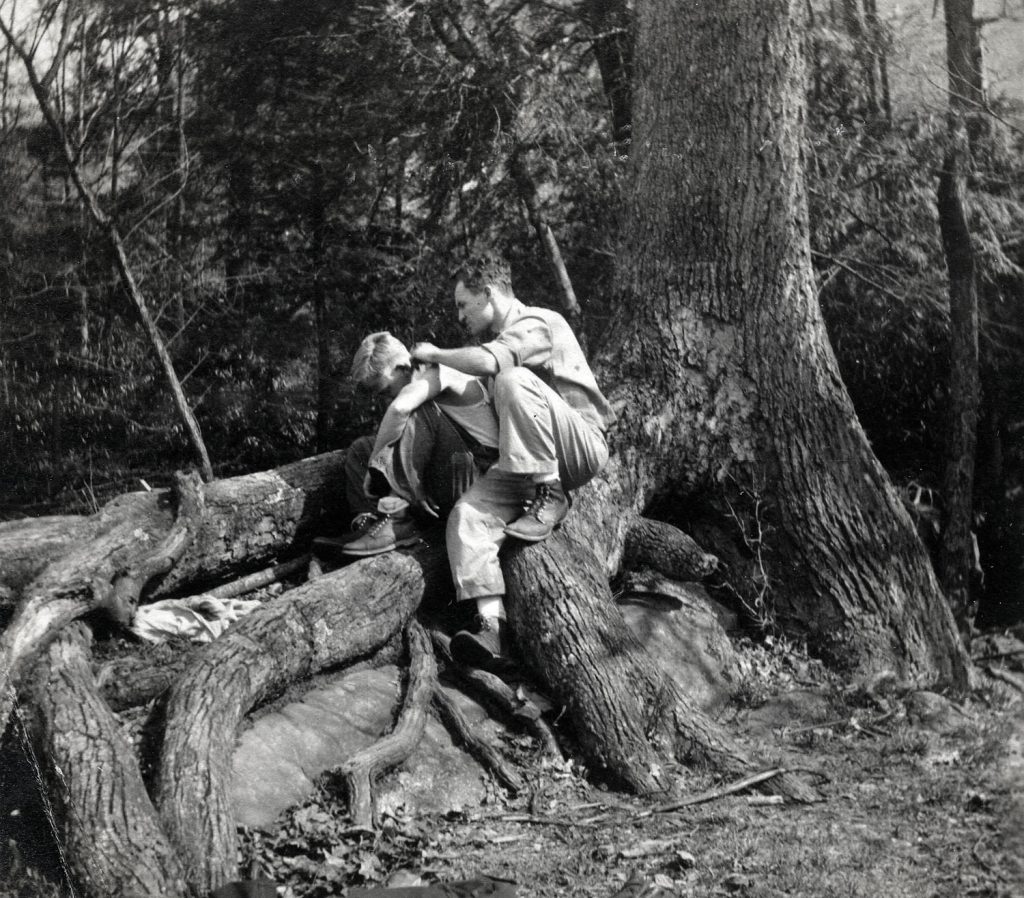
2457 Clyde Blanton and August Angel cutting hair at large poplar on playground, 1930s. [IX_students_09_2457_001.jpg]
- Mules and two women workers on mule-back with man walking in rocky rail-fenced lot. [X_099_workers_2486_mod.jpg]
- Woman seated on a mule next to mounting rock and boy assistant. Note the fur around her neck. Mounting stone was just opposite Big Log. [X_099_workers_2527b_mod.jpg]
- Maya Sudo Album: Maya seated on large rock. [sudo_album_051b_mod.jpg]
- Medical Settlement, Big Laurel. Path, steps and coal-bucket. [nesb_007_mod.jpg]
- “At Jack’s Gap. A group of 9 young men.” Kendall Bassett Photograph Album, c. 1928-29. [pmss001_bas012.jpg]
- Students, musicians. Katherine Pettit Album I. [pettit_27_003.jpg]
- Mattie Ayers Hayes and Ruth Creech at Jack’s Gap. [VI_51_friends_neighbors_1722x_mod.jpg]
- Board of Trustees seated on the steps at Boy’s House, 2007. [2007_board_001.jpg]
- Katherine Pettit Album I. [pettit_26_003.jpg]
- Former BOT member Chad Berry on a PMSS boulders. [P1040297.jpg]
- Boys House stone stairs to first level of building.
- Building stone wall. VII 63 Life Work Maintenance, Farm, Grounds.
- Rock bench in front of Laurel House II. rockwork_027_laurelhouse_bench_flagstone
- Capturing a snapping turtle in Greasy Creek. VI-51 – 1627.
The stone steps of Boy’s House have long been a favorite photography venue for Board pictures, students, and solitary musing. A special stone pulled from the steps of the Creech cabin was crafted by Andy Dorsky, a talented stone carver, into a seat where visitors may view the cabin.
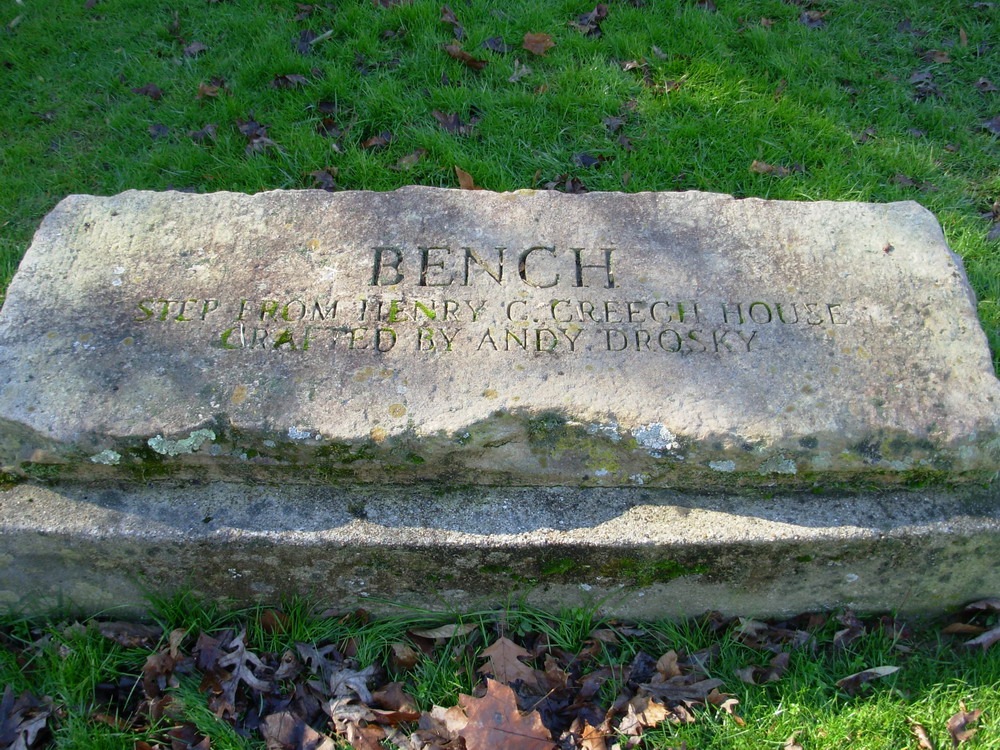
POTATOES AND ROCKS
Not all rocks are stones. Potatoes were a popular crop in the mountains, but rocks and potatoes do battle in the field. It is difficult to grow potatoes in rocky fields, thus all workers took on the task of clearing the fields of rocks and turning them into construction stones:
“Another piece of economy has been the application of the two-birds-with-one-stone theory to the loose stones on our cultivable ground. We have secured building material for two sanitary closets and a fine tool house by gathering wagon loads of obstructive stone from our potato fields. As to rocks, we still have more worlds to conquer and we shall use them for building and retaining walls, paving, and roads.”
Nov. 14, 1914, Letter to Friends from Ethel de Long
DRY STACK CONSTRUCTION AND SCALLOPED POTATOES
In recent years Pine Mountain has held several workshops in dry-stack wall construction. The sinuous wall along the road from the Office to the Industrial Building (Plant Center) is a good example of the work of dry-stacking.
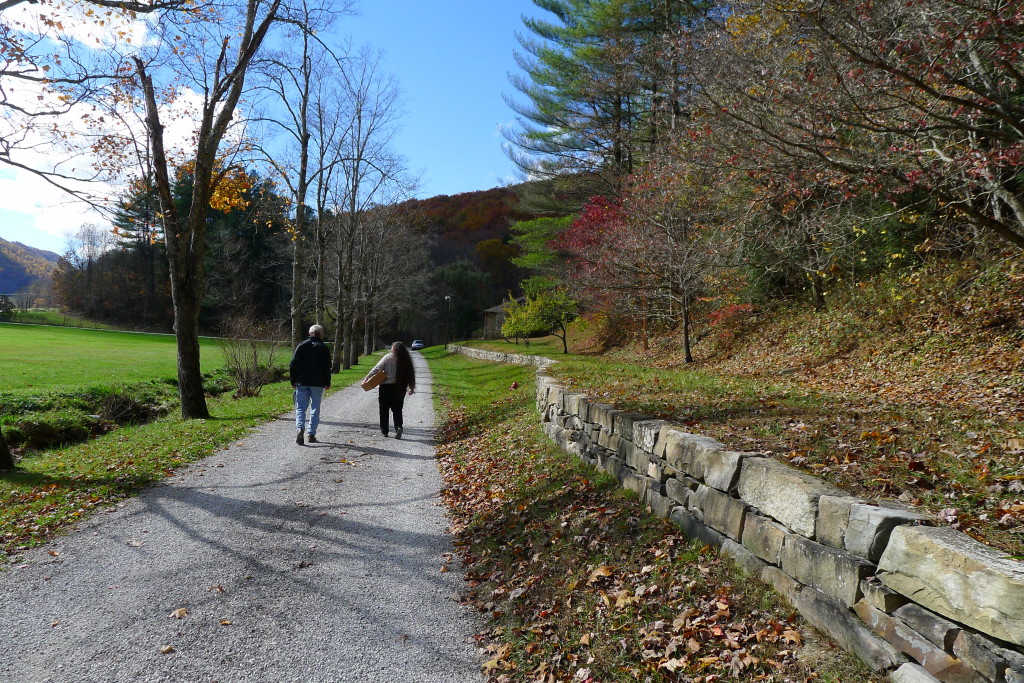
Stone wall along road from Office to Industrial Building. [P1050413.jpg]
Dry-stack rock work was a workshop offered at the School and it can be a valuable skill for both a gardener or a cook. Both take a good eye! Dry-stack rock work may be seen throughout the School campus. Many of the walls are early drystack, but many are also the new and repaired work of the dry stack crews in training. A recent preservation workshop that re-built the wall just east of the Office were possibly treated to a meal with scalloped potatoes. It is not known if the masons were rewarded with the scalloped potatoes, but the following recipe is one drawn from the records of the School and would go well with a day of dry stacking.
SCALLOPED POTATOES
Scalloped potatoes? They actually have much in common with stacked stones. Potatoes are often what cause a stone to be moved, removed, stacked, broken up, hated or other actionable scenarios. Like dry stacked walls, scalloped potatoes are laid into the pan one slice on top of the other. In the kitchen the idea is “light-weight” but in the field, it is an exercise in heavy lifting.
SCALLOPED POTATOES
3 LB potatoes
4 T butter
4 T flour
2 t salt
1/4 t pepper
2 cups milk
Pare and dice potatoes and put in a buttered baking dish, sprinkling each layer lightly with the flour, salt, and pepper. Pour milk and melted butter over the potatoes. Cover, bake in moderate oven for 60 to 90 minutes.
Recipe in The Pine Cone, May 1935
GALLERY OF STONEWORK AT PMSS see ROCKWORK
Stones were life-long labor for farmers at the School as well as in the community farms and gardens. Some areas were more troublesome than others. The barnyard seen here was slow to be cleared of these troublesome partners of most mountain soils. But when “clearing” was completed, the stones were ordered into a rough paving behind and in front of the barn where the mud and muck was an ever-present nuisance.
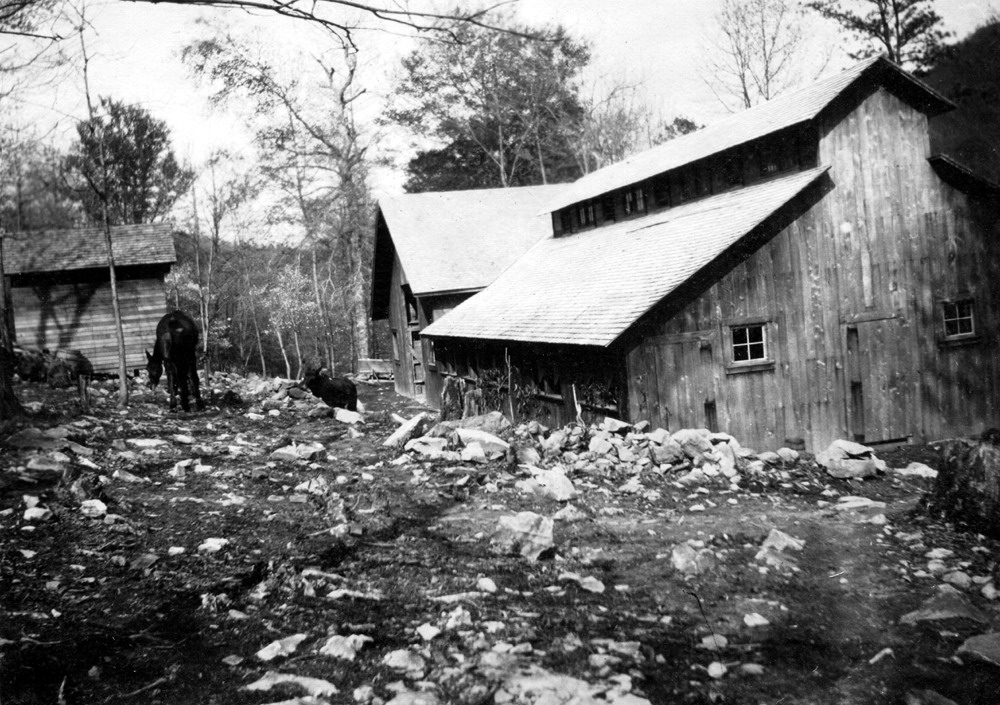
Barn. Early construction with stones littering yard. [II_7_barn_281.jpg]
- “Ayrshire Herd 1948.” Barn and silo in background. [nace_II_album_041.jpg]
- Boy and wheelbarrow and stone-paved barnyard. [II_7_barn_275.jpg]
HORSES AND ROCKY ROADS, TRAILS AND PATHS
The stories of negotiating rocky streambeds on the backs of horses or in wagons abound in the Pine Mountain Valley. Steep mountain slopes and laurel thickets offered poor trails and often the thoroughfares were the streambeds. One story stands out in the myriad of tales of rocky-stream mishaps. This tale of the fall of Dr. Alfreda Withington on a dark night medical call is particularly memorable. In her own words from her autobiography, Mine Eyes Have Seen (E.P.Dutton & Company, 1941) she describes the 1926 accident that began when she was called to treat a child who had been badly burned. Dr. Withington had stayed the night with the family. As she started the next day on the long trip back to the Medical Settlement at Big Laurel by horseback she had what she described as “bad luck.”
It was the next day when I was returning alone from this visit, that bad luck overtook me. As Maud [the horse] was going downhill she stumbled on a rock, falling and hurling me straight over her head, so that I struck almost squarely on my face. I remember the sensation of hurtling through the air and hearing a crash. Then there was a blank
A mountain woman was standing over me when I came to. I had an awareness that something was wrong; putting my hand to my nose felt it crunch, and it was bleeding terribly. I told the woman to give me my kit, and lying there I manipulated the grating bones, straightened them, and poked some gauze up my nostrils. Though faint from loss of blood there was nothing for me to do but remount and ride the four miles home.
The next day my face was swollen beyond recognition. I rode thirteen miles more to the railroad and took the night train for Louisville to consult a specialist. He said I could be thankful indeed that my malar bones were not smashed; a stiff hat saved them.
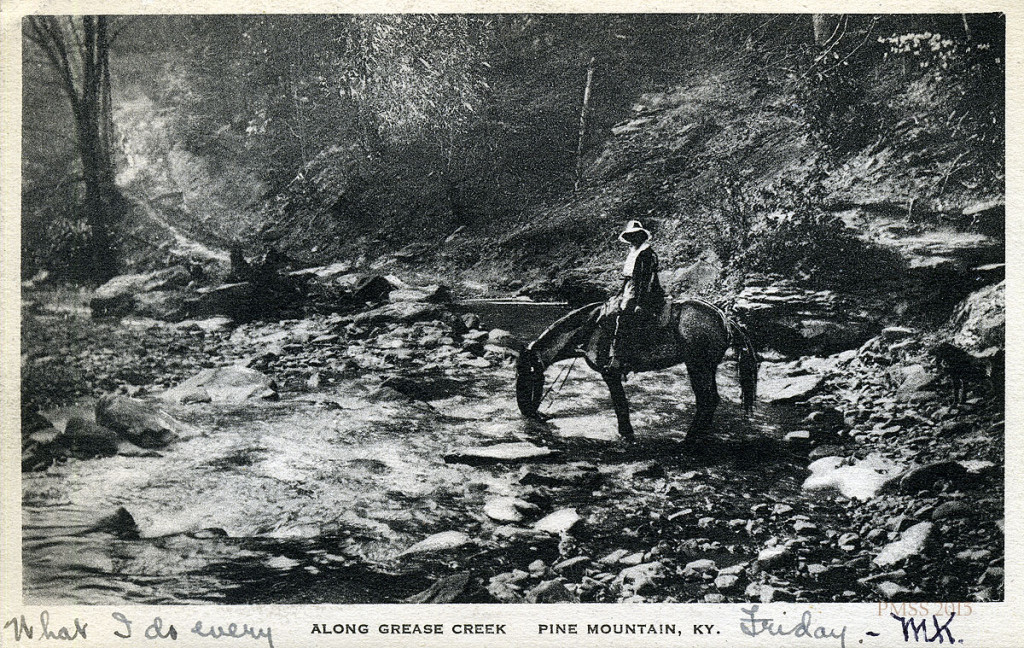
“What I do every Friday. M.K.. [Marian Kingman] Along Grease [sic] Creek, Pine Mountain, Ky.” [kingman_098a.jpg]
SCENIC ROCKS AND HIGH PLACES
Indian Rock, Rebel’s Rock, Raven’s Rock, arches,. Sandstone cave…..
- Celia Cathcart seated on rock at Jack’s Gap, above PMSS. [hook_album_2blk__034.jpg]
- Students on cliff at Jack’s Gap on top of Pine Mountain. [kingman_037b.jpg]
- Katherine True Album: “E.K.R. [Enid K. Rutledge] Jack’s Gap.” [pmss_tru076.jpg]
- Rebel’s Rock. [cobb_alice_019.jpg]
- 0067b P. Roettinger Album. “Great Rock at the top of Pine Mountain.” [Three people visible just past tree line in forefront.] [roe_067b.jpg]
- Jack’s Gap outing. Arthur W. Dodd Album. [dodd_A_066_mod.jpg]
- Jack’s Gap. Katherine Pettit (older woman with hat to left of image) and Ethel de Long (back against pine tree) and children at Jack’s Gap, above PMSS. [X_099_workers_2524a_mod.jpg]
- Indian Rock with borders of daisies. Photo by HHW. [P1130870.jpg]
STONE SOUP
Besides scalloped potatoes, there is Stone Soup. Any soup may become “stone-soup” when a clean and dense stone is heated intensely and dropped into a soup pot. It acts like a slow cooker and it both cooks and maintains the warmth of a meal. The following is a pleasant winter stone soup made from stored and home-canned goods.
Vegetable Stone Soup
1 cubed onion, braised (or added directly to pot)
1 qt. jar of tomatoes
1 qt. jar of corn
1 qt. jar of green beans
3 cups of beef broth
1 tsp dry oregano
1 tsp salt
1/2 tsp pepper
One clean medium stone thoroughly heated. Place stone directly in soup mixture. Let cook for 1 hour. Patience. Re-heat stone, if needed. Serve with cornbread. and cold buttermilk.
To explore the many uses of stones and rocks at Pine Mountain a quick look at the built environment, of foundations, steps, walls, etc.. All will give a good overview of the value and required skills to utilize this building material. Buildings that are noteworthy for their rockwork are the Chapel, Laurel House II, and Draper Industrial Building. Rockwork, as seen in ROCKWORK at PMSS can also demonstrate some of the troublesome aspects of this medium.
PLAYING IN THE ROCKY, STONEY, BOULDER STREWN CREEK
Ann Angel Eberhardt, the other editor and voice on the Pine Mountain Settlement School Collections website (there are two of us) shared the following story. Ann is a cousin, a friend, a writer and a superlative sounding-board. Her father is the hair-cutter in the photograph above. When she read this piece about stones … she felt compelled to share some of her memories among the stones of Pine Mountain. I am sure other readers will have similar memories especially of the creeks of Eastern Kentucky. I asked if I could share her memories of visiting near the right fork of Mason’s Creek in Perry County.
Your article reminds me of those times my family would regularly visit Mom’s people, the Halls, in Viper in the summers of 1940s & early 50s. We cousins would spend most days setting up little “playhouses” on the huge boulders in the creek. Each of us would have his or her own boulder (stone?) and use twigs, pebbles, stones, discarded items, and anything else we could find to create our playhouses. One cousin even directed the creek in a way to have “running water.” There was a perfectly round hole in the rocky creekbed that we called “Indian’s washbowl.” It was probably formed by eons of circling pebbles that the creek water washed into it.
Sound familiar?
Helen Hayes Wykle
SEE ALSO:
FARM and FARMING Guide
FARM Guide to Resources
FARM LIME KILN Processing

